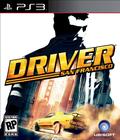It's been four years since the Driver series has seen a significant release. The series is seeking to bring back many old ideas while throwing in some positively insane new concepts. A few minutes at E3 with Driver: San Francisco showed that the series' classic car chases have made the high-definition jump well — perhaps well enough to wash away the bad taste of Driver: Parallel Lines.
San Francisco, like Parallel Lines, takes place in just one location. Formerly undercover cop John Tanner, who was the protagonist of the first three games, makes a return, along with rival Charles Jericho, who originated in Driver 2. Both have survived the final events of Driv3r and end up going at it again — until Tanner is knocked into a coma during a head-on collision. The rest of the game is Tanner's coma dream, and while this might seem like a plot cop-out, Reflections' rep was convinced that it could revive the series.
The basic gameplay is similar, with highly damageable cars going from objective to objective across sprawling environments. The cars will occasionally get involved in nasty chases with the police and other sources of trouble, often ending in highly impressive crashes. The formula's old, but it's still fun. The coma provides a nice twist in the form of a useful new ability: being able to jump from car to car. I don't mean that Tanner can leap out of one vehicle to hijack another; instead, the camera pulls away from his car and takes on a sepia tone. As play continues in super-slow motion, the player can choose another car, and then that becomes the car that Tanner is driving. His old ride goes off in its own direction, or, if you were careening toward a crash, it goes ka-boom.
As the game progresses, the shifting ability continues to develop until Tanner is eventually able to jump into cars at the opposite end of town. This mechanic also provides side missions. As Tanner looks from outside a car, he may notice certain riders who are having problems. Just jump into their car and resolve the issue. Tanner's coma dreams neatly explain why no one ever complains about suddenly becoming the passenger while an undercover cop with a penchant for Hollywood-style chases is driving their car.
Other than distance, the shifting mechanic shows next to no limits. The Reflections rep jumped into a car, crashed it, jumped to another vehicle and then another, quickly creating a pileup that would impress a typical Burnout player — with little to no visible slowdown in the graphics. This time around, all 100 different types of vehicle in the game are licensed but still fully destructible, so familiar cars were all over the pile of mayhem that we'd just created.
While it doesn't set any new standards, the game's graphics were strong, solid and realistic, not once distracting from the action. Occasional character cut-ins provided voice details while preserving an action-packed, classic Hollywood feel to the story lines. Sounds were less of a focus during this demo, though the engine noises and blasts were pretty tight and matched the screen mayhem well enough.
Driver: San Francisco brings its traditional vehicular mayhem to modern consoles next year. So far, it looks like the game will pull off what Parallel Lines couldn't.
More articles about Driver: San Francisco











 Gamers play as Detective John Tanner on a relentless manhunt for crime lord Charles Jericho through the hills of the City by the Bay. With its timeless setting, unique car handling and renewed playability, and over 100 licensed vehicles, Driver San Francisco will revitalize the classic free-roaming, cinematic car chase experience.
Gamers play as Detective John Tanner on a relentless manhunt for crime lord Charles Jericho through the hills of the City by the Bay. With its timeless setting, unique car handling and renewed playability, and over 100 licensed vehicles, Driver San Francisco will revitalize the classic free-roaming, cinematic car chase experience.







